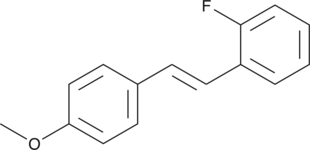Description
A macrocyclic trichothecene mycotoxin that has been found in M. verrucaria; inhibits FGFR3, IGF-1R, PDGFRβ, and TrkB (IC50s = 0.4, 0.4, 1.4, and 1 μM, respectively); induces cytotoxicity in multiple breast cancer cell lines (IC50s = 0.02-0.05 nM); inhibits proliferation in a panel of additional cancer cell lines (IC50s = 50s = 1.74-7.68 nM); inhibits the growth of P. falciparum (EC50 = 0.15 ng/ml); induces phytotoxicity in duckweed and kudzu; toxic to mice (LD50 = 10 mg/kg, i.p.); also produced by the plant B. coridifiola, which is associated with livestock poisoning in South America
Formal name: (2’E,7’R)-2′,3′-didehydro-7′-deoxo-2′-deoxy-7′-[(1R)-1-hydroxyethyl]-verrucarin A
Synonyms:
Molecular weight: 514.6
CAS: 16891-85-3
Purity: ≥95%
Formulation: A solid
Product Type|Biochemicals|Antiparasitics|Antiprotozoals||Product Type|Biochemicals|Kinase Inhibitors|FGFR Family||Product Type|Biochemicals|Kinase Inhibitors|IGF-1R/InsR Family||Product Type|Biochemicals|Kinase Inhibitors|PDGFR Family||Product Type|Biochemicals|Small Molecule Inhibitors|Kinases||Product Type|Biochemicals|Toxins|Mycotoxins||Research Area|Cancer|Cell Death||Research Area|Immunology & Inflammation||Research Area|Infectious Disease|Parasitic Diseases|Malaria||Research Area|Toxicology|Environmental



